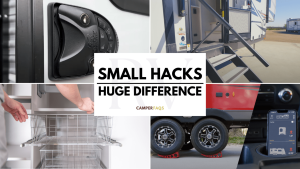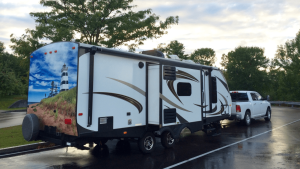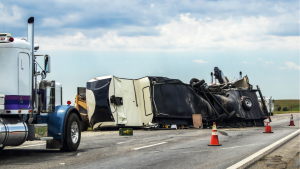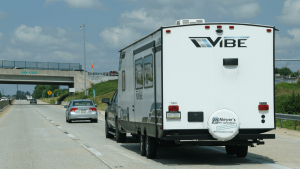Camper FAQs is reader-supported. Buying through links on our site may earn us an affiliate commission. As an Amazon Associate I earn from qualifying purchases.
Retirement and RVing go hand in hand for a lot of folks. You’ve got the time, the freedom, and maybe even a bucket list of places you’ve been meaning to visit for years.
But hitting the road in your later years brings a few unique challenges too – from mobility to meds to keeping things simple and safe.
That’s why we gathered these practical tips straight from seasoned senior RVers who know what works and what’s worth skipping.
Choosing the Right RV Setup
1. You’ve Got Options – Lots of Them
Age doesn’t mean you have to stick to one type of RV. Class A, Class C, travel trailers, fifth wheels – if you’re able to drive or tow it safely, it’s fair game. What matters is how it fits your needs. Some folks prefer the convenience of motorhomes, while others like having a tow vehicle they can use to run errands or sightsee.
2. Fifth Wheels Work Great for Long Stays
If you plan to stay parked in one spot for a while, a fifth wheel can be a great option. They tend to offer more space, and the hitch design makes towing more stable. You’ll have to deal with steps inside, though, since the bedroom is usually raised.
3. Motorhomes Are Easier If You Don’t Want to Deal With Hitching
If the idea of hooking and unhooking a trailer sounds like a hassle, a motorhome might be a better choice. You can just park and go. A lot of RVers in their 60s, 70s, and beyond like that they can use the bathroom or grab a snack without ever leaving the vehicle during travel days.
4. Go With a No-Step Floor Plan If Mobility’s an Issue
For those with knee or back issues, single-level layouts make a big difference. Travel trailers often have flat floors with no interior stairs, which can be easier to move around in day to day. You’ll still have to climb up stairs to get into your camper, but we have a few tips below to help with that.
5. Try Before You Buy
If you’re thinking about a specific type of RV but haven’t owned one before, rent something similar for a weekend. That way, you’ll know if you’re comfortable driving it, sleeping in it, and using the space before making a long-term commitment.
Step and Entry Safety
6. Light Up the Stairs
Interior steps can be tricky at night, especially when you’re half asleep. Add small LED strip lights along the edges, or stick-on tap lights if you want something quick. For your outside steps, glow-in-the-dark tape is a cheap upgrade that helps you see where you’re stepping after sunset. Both add visibility without messing with your setup too much.
7. Swap Out the Standard RV Steps for a “StepAbove” or “Solid Step” System
These steps fold down and rest directly on the ground, which makes them much more stable than the hanging kind. They’re wider, don’t bounce, and usually include built-in anti-slip tread. MORryde and Lippert both make versions that are popular with older RVers.
8. Add a Grab Handle by the Door
Some RVs already come with one, but if yours doesn’t, it’s worth adding. A handle helps you balance as you step in or out, especially when the ground is uneven or the weather’s bad. Look for folding handles made for RVs as they’re easy to install and store flat when not in use. Stromberg Carlson is one of the top rated brands.
9. Add Non-Slip Strips
Even if your steps are sturdy, they can still get slick in rain or dew. Stick-on tread strips or anti-slip tape give your shoes something to grip. It’s one of those little things that’s barely noticeable until you slip without it.
Bathroom Comfort and Safety
10. Switch to a Taller Toilet
Some RV toilets sit low to the ground, which can make standing up harder. Swapping in a “high profile” RV toilet, like the Aqua Magic High Profile RV Toilet, adds a few extra inches, which is often enough to make a noticeable difference in comfort and safety.
11. Walk-In Showers Are Worth It
A low-threshold shower is easier to step into and out of. Some larger RVs come with these by default, or you might find a model with a small built-in seat. If you’ve ever felt uneasy balancing in a tight shower, this is one upgrade that can make daily routines way less stressful.
12. Install a Grab Bar in the Shower
Even if you don’t think you need one now, it’s a smart move. Wet feet and small spaces don’t mix well. A wall-mounted handle gives you something to hold onto if you slip or lose your balance. It’s a simple install and adds peace of mind.
13. Use a Shower Stool or Folding Seat
If balance is a concern or you’re dealing with fatigue, a compact, waterproof shower stool helps a lot. Some RVers install a flip-down wall seat, while others use a free-standing stool that stores easily when not in use.
14. Replace the Shower Head With a Handheld Sprayer
A handheld sprayer lets you sit while showering and control the water without turning or reaching. It also helps with rinsing off quickly, which reduces time standing on a wet surface.
15. Use a Non-Slip Shower Mat or Strips
Shower pans can get slick. Pick up a non-slip shower mat or install adhesive strips made for tubs and showers. Go with something mildew-resistant and easy to clean, so you don’t have to mess with it all the time.
16. Add a Handle Next to the Toilet
This one doesn’t get talked about much, but it helps. Getting up from the toilet can be harder than expected, especially if your knees or hips aren’t what they used to be. A small grab handle nearby gives you leverage and support without needing to hold onto something unstable.
Lighting and Visibility
17. Make the Inside Brighter
Vision changes with age, and RVs aren’t always known for having the best lighting. Add battery-powered push lights inside cabinets, under shelves, and in darker corners. They’re cheap, easy to install, and make it easier to find what you’re looking for day or night.
18. Don’t Skip the Exterior Lights
Good outdoor lighting helps you see where you’re going and also makes your RV less of a target if you’re parked somewhere unfamiliar. Most newer rigs have decent built-in lights, but you can add motion-sensor LEDs or solar lights if yours is lacking.
19. Add a Rechargeable Lantern as a Backup Light Source
Keep a compact rechargeable lantern by the bed or near the door. If you lose power or need to walk around outside, it’s easier to carry than a flashlight and provides broader lighting. Some models can also charge your phone if needed.
Accessibility and Ergonomics
20. Make Daily Tasks Easier
Many RV features can be manual or powered. If bending, cranking, or reaching is tough, consider powered stabilizers, awnings, or tongue jacks. If your RV doesn’t already have them, some upgrades are worth the investment. You don’t have to strain just to set up or pack down.
21. Organize and Label Storage
RV cabinets and compartments can turn into black holes fast. Use clear bins with labels so you’re not digging around every time you need something. Motion-sensor lights inside storage areas are another helpful add-on that saves time and frustration.
22. Bring a Small Folding Cart or Wagon
A folding wagon will come in handy more than you’d think. Use them for groceries, laundry, or hauling hoses and gear at campgrounds. You won’t need to carry heavy stuff across gravel or uneven ground, and they fold up small when not in use.
23. Invest in a Comfy Chair and Bed
Camp chairs aren’t all the same. Look for one with good back support and easy-to-use armrests. Same goes for your bed as many RV mattresses are thin or lumpy. A mattress topper or upgraded mattress can make a big difference, especially if you’re on the road for more than a few nights at a time.
Health and Medical Considerations
24. Pack an Extra Pair of Glasses
Always carry a backup set of prescription glasses. If you’re driving, this isn’t just smart, it’s a safety thing. You might be far from the nearest place that can replace a broken pair, so having a second set on hand just makes sense.
25. Bring a Full Supply of Medications
Before a trip, go through all your prescriptions and refill what you can. Store them in a cool, dry spot where they won’t get overheated. On travel days in hot weather, consider keeping them in the cab of your vehicle where there’s air conditioning.
26. Use a Pharmacy Chain With Locations Nationwide
Big chains like CVS, Walgreens, and Walmart can refill your prescriptions across state lines. You can also bring a paper copy of your prescriptions in case you end up somewhere that doesn’t have one of the major chains nearby.
27. Ask Your Doctor About Remote Access
If you’ve got a good relationship with your regular doctor, see if they’ll stay in touch while you’re on the road. Many are open to phone calls or telehealth visits these days, which can save you from having to see a new doctor every time something comes up.
28. Schedule Checkups When You’re Back Home
If you’ve got regular appointments or health screenings, try to group them together and plan a return trip around them. That way, you don’t have to figure things out on the road or see unfamiliar providers unless it’s absolutely necessary.
29. Set Up Medication Reminders
Travel routines are different from home, so it’s easy to forget a dose. Use a weekly pill organizer, an app on your phone, or even just an alarm to keep you on track.
30. Keep Paper Copies of Important Health Info
Print out your medication list, emergency contacts, and insurance info. Store them in an easy-to-reach folder. If your phone battery dies or you don’t have service, you’ll still have everything you need.
Safety and Communication
31. Sign Up for Roadside Assistance
Things go wrong sometimes – flat tires, dead batteries, locked doors. Having a roadside assistance plan that covers your RV means you won’t be stuck figuring it out alone. Good Sam, Coach-Net, and AAA all offer plans for RVs. Make sure the one you choose covers your vehicle type and the areas you’ll be traveling.
32. Stay Connected With Starlink
Cell service can be spotty once you leave major roads or campgrounds. Starlink provides satellite internet that works in a lot of remote areas, so you can still check emails, use maps, or call family using Wi-Fi. It’s not perfect everywhere, but if you’re full-timing or boondocking a lot, it’s one of the best options available right now.
33. Stay in Touch With Family Using Video Calls
Apps like FaceTime, Skype, and Zoom are easy ways to check in with loved ones while you’re away. You don’t need a fancy setup, just a smartphone and a decent signal or Wi-Fi connection. Regular check-ins also give peace of mind to the folks back home.
Family and Social Life
34. Add a Hide-A-Bed for the Grandkids
You probably don’t need bunk beds year-round, but it’s nice to have space for the grandkids when they visit. A hide-a-bed sofa or convertible dinette lets you keep your main setup simple and still have a place for little ones to crash when they tag along.
35. Join an RV Club
RV clubs are a great way to meet others who enjoy the same lifestyle. Groups like Escapees, Good Sam, and Passport America offer campout events, discounts, and resources. Some even have chapters focused on solo travelers or women RVers. It’s a low-key way to make friends and find good spots to stay.
36. Get Involved in Facebook Groups and Forums
Online RV communities are free, active, and full of helpful folks. You can ask questions, share tips, or even arrange to meet up with people at the same campground. It’s a simple way to stay connected and pick up real advice from people who’ve been there.
37. Travel With a Group
If you’re not into solo travel, consider caravan trips. These are small groups of RVers traveling the same route together. You still have your own rig and space, but there’s a sense of community and some shared planning. It’s also a little extra peace of mind if you’re headed somewhere new.
38. Try a Rally
Rallies are organized meetups that usually involve camping, food, and group activities. Some are tied to RV clubs, while others are open to anyone. It’s a chance to relax, meet people, and talk RV life with folks who get it.
Money-Saving Tips
39. Get an AARP Membership
AARP offers discounts on things like campgrounds, dining, travel, and more. If you’re 50 or older, you can join. The membership is inexpensive and pays for itself quickly if you take advantage of the deals.
40. Pick Up the America the Beautiful Senior Pass
If you’re 62 or older and a U.S. citizen or permanent resident, you qualify for the Senior Pass. It’s $20 for an annual pass or $80 for a lifetime version. It gets you into national parks, monuments, and federal recreation sites. Plus, it often covers everyone in your vehicle, including the grandkids.
Travel Habits and Attitude
41. Use a Setup and Departure Checklist
It’s easy to forget steps when you’re setting up or packing up, especially if you’re tired or distracted. A printed checklist keeps you from missing things like raising the jacks, unplugging the power cord, or locking the fridge. It saves time, prevents damage, and lowers stress. Keep one for setup, one for breakdown, and maybe a third for towing or departure day routines.
Check out our printable RV & Camping Checklists to help you stay organized.
42. Don’t Rush
Take your time when leaving a campsite or driving to the next one. Rushing leads to mistakes – missed steps, forgotten gear, or even accidents. Give yourself extra time for setup and travel so you’re not stressed about the clock.
43. Have Fun With It
There’s always a learning curve when starting something new, even if you’ve been camping before. Give yourself some grace while figuring things out. RVing in your retirement years should be enjoyable, flexible, and full of new memories.
Let us know what tips you swear by in the comments below!







Write a comment